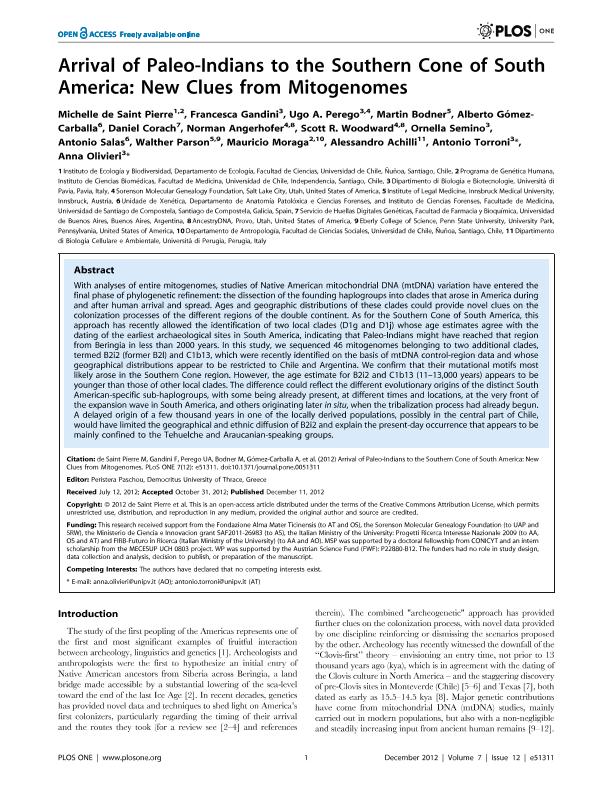Mostrar el registro sencillo del ítem
dc.contributor.author
de Saint Pierre, Michelle
dc.contributor.author
Gandini, Francesca
dc.contributor.author
Perego, Ugo A.
dc.contributor.author
Bodner, Martin
dc.contributor.author
Gómez Carballa, Alberto
dc.contributor.author
Corach, Daniel

dc.contributor.author
Angerhofer, Norman
dc.contributor.author
Woodward, Scott R.
dc.contributor.author
Semino, Ornella
dc.contributor.author
Salas, Antonio
dc.contributor.author
Parson, Walther

dc.contributor.author
Moraga, Mauricio
dc.contributor.author
Achilli, Alessandro
dc.contributor.author
Torroni, Antonio
dc.contributor.author
Olivieri, Anna
dc.date.available
2023-05-29T14:31:59Z
dc.date.issued
2012-12
dc.identifier.citation
de Saint Pierre, Michelle; Gandini, Francesca; Perego, Ugo A.; Bodner, Martin; Gómez Carballa, Alberto; et al.; Arrival of Paleo-Indians to the Southern Cone of South America: New Clues from Mitogenomes; Public Library of Science; Plos One; 7; 12; 12-2012; 1-9
dc.identifier.issn
1932-6203
dc.identifier.uri
http://hdl.handle.net/11336/198809
dc.description.abstract
With analyses of entire mitogenomes, studies of Native American mitochondrial DNA (mtDNA) variation have entered the final phase of phylogenetic refinement: the dissection of the founding haplogroups into clades that arose in America during and after human arrival and spread. Ages and geographic distributions of these clades could provide novel clues on the colonization processes of the different regions of the double continent. As for the Southern Cone of South America, this approach has recently allowed the identification of two local clades (D1g and D1j) whose age estimates agree with the dating of the earliest archaeological sites in South America, indicating that Paleo-Indians might have reached that region from Beringia in less than 2000 years. In this study, we sequenced 46 mitogenomes belonging to two additional clades, termed B2i2 (former B2l) and C1b13, which were recently identified on the basis of mtDNA control-region data and whose geographical distributions appear to be restricted to Chile and Argentina. We confirm that their mutational motifs most likely arose in the Southern Cone region. However, the age estimate for B2i2 and C1b13 (11–13,000 years) appears to be younger than those of other local clades. The difference could reflect the different evolutionary origins of the distinct South American-specific sub-haplogroups, with some being already present, at different times and locations, at the very front of the expansion wave in South America, and others originating later in situ, when the tribalization process had already begun. A delayed origin of a few thousand years in one of the locally derived populations, possibly in the central part of Chile, would have limited the geographical and ethnic diffusion of B2i2 and explain the present-day occurrence that appears to be mainly confined to the Tehuelche and Araucanian-speaking groups.
dc.format
application/pdf
dc.language.iso
eng
dc.publisher
Public Library of Science

dc.rights
info:eu-repo/semantics/openAccess
dc.rights.uri
https://creativecommons.org/licenses/by-nc-sa/2.5/ar/
dc.subject
mtDNA
dc.subject
Paleo Migrations
dc.subject
American Southern Cone
dc.subject.classification
Genética y Herencia

dc.subject.classification
Ciencias Biológicas

dc.subject.classification
CIENCIAS NATURALES Y EXACTAS

dc.title
Arrival of Paleo-Indians to the Southern Cone of South America: New Clues from Mitogenomes
dc.type
info:eu-repo/semantics/article
dc.type
info:ar-repo/semantics/artículo
dc.type
info:eu-repo/semantics/publishedVersion
dc.date.updated
2023-05-29T12:17:25Z
dc.journal.volume
7
dc.journal.number
12
dc.journal.pagination
1-9
dc.journal.pais
Estados Unidos

dc.journal.ciudad
San Francisco
dc.description.fil
Fil: de Saint Pierre, Michelle. Universidad de Chile; Chile
dc.description.fil
Fil: Gandini, Francesca. Universita degli Studi di Pavia; Italia
dc.description.fil
Fil: Perego, Ugo A.. Universita degli Studi di Pavia; Italia
dc.description.fil
Fil: Bodner, Martin. Universidad de Innsbruck; Austria
dc.description.fil
Fil: Gómez Carballa, Alberto. Universidad de Santiago de Compostela; España
dc.description.fil
Fil: Corach, Daniel. Universidad de Buenos Aires. Facultad de Farmacia y Bioquímica. Servicio de Huellas Digitales Genéticas; Argentina. Consejo Nacional de Investigaciones Científicas y Técnicas; Argentina
dc.description.fil
Fil: Angerhofer, Norman. No especifíca;
dc.description.fil
Fil: Woodward, Scott R.. No especifíca;
dc.description.fil
Fil: Semino, Ornella. Universita degli Studi di Pavia; Italia
dc.description.fil
Fil: Salas, Antonio. Universidad de Santiago de Compostela; España
dc.description.fil
Fil: Parson, Walther. Universidad de Innsbruck; Austria
dc.description.fil
Fil: Moraga, Mauricio. Universidad de Chile; Chile
dc.description.fil
Fil: Achilli, Alessandro. Università di Perugia; Italia
dc.description.fil
Fil: Torroni, Antonio. Universita degli Studi di Pavia; Italia
dc.description.fil
Fil: Olivieri, Anna. Universita degli Studi di Pavia; Italia
dc.journal.title
Plos One

dc.relation.alternativeid
info:eu-repo/semantics/altIdentifier/url/https://journals.plos.org/plosone/article?id=10.1371/journal.pone.0051311
dc.relation.alternativeid
info:eu-repo/semantics/altIdentifier/doi/http://dx.doi.org/10.1371/journal.pone.0051311
Archivos asociados
